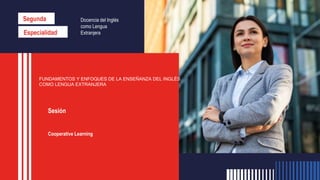
educación en inglés de la universidad UCV
- 1. Segunda Especialidad FUNDAMENTOS Y ENFOQUES DE LA ENSEÑANZA DEL INGLÉS COMO LENGUA EXTRANJERA Sesión Cooperative Learning Docencia del Inglés como Lengua Extranjera
- 2. Resultado de aprendizaje Demuestra conocimientos teóricos y prácticos de los fundamentos pedagógicos y didácticos que intervienen en la enseñanza del idioma inglés como lengua extranjera. Evidencia de aprendizaje Producto Académico Individual (PAI): Control de Lectura sobre los diversos enfoques y métodos e inteligencias múltiples Examen Parcial: Análisis y comparación de 2 métodos de la enseñanza del idioma inglés como lengua extranjera: Content based learning y Situational Language Approach
- 4. Let´s watch a video
- 5. What is Cooperative learning? Cooperative learning is an educational learning strategy based on developing a practice in small groups focused on achieving a common goal. Compared to structures based on competitiveness and production of more traditional education, cooperative learning achieves high group performance, but also of each of its members.
- 6. Let´s watch a video
- 7. • According to experts, better learning is achieved because it improves: • Motivation. • Interaction among classmates. • Information processing strategies. • Communication. • Interpersonal and cognitive skills.
- 8. Basic components of cooperative learning • Cooperative learning requires the following five essential components to be successful.
- 9. Positive interdependence • The teacher must propose a clear objective to the group and make it clear that the efforts of each member benefit themselves and the group.
- 10. Individual and group responsibility • Each person takes responsibility for doing their share of the work. This avoids what psychologists call social loafing, i.e.. It eliminates the possibility of some members taking advantage of the work of others. • Group responsibility also makes it possible to evaluate each student’s performance separately to determine who needs to be helped or supported. Each member comes out of the practice stronger.
- 11. Stimulative interaction • This interaction strengthens the relationships among members Each student promotes the success of the others, helping and congratulating each other, thus promoting social commitment.
- 12. Teaching interpersonal and group practices. • The teacher must provide students with the necessary tools to achieve social integration and encourage them to function as a team.
- 13. Group evaluation • Group members should analyze how teamwork is developing and how they can improve their effectiveness in achieving their objectives.
- 18. Team work • Mention the roles for teachers and students in CL.
- 19. Discuss about the difference between https://www.prometheanworld.com/resource- center/blogs/collaborative-vs-cooperative-learning/
- 22. Let´s watch a video
- 23. What is Collaborative learning? A collaborative learning approach involves pupils working together on activities or learning tasks in a group small enough to ensure that everyone participates. Pupils in the group may work on separate tasks contributing to a common overall outcome, or work together on a shared task. This is distinct from unstructured group work.
- 25. Why use collaborative learning? Research shows that educational experiences that are active, social, contextual, engaging, and student-owned lead to deeper learning. The benefits of collaborative learning include: • Development of higher-level thinking, oral communication, self- management, and leadership skills. • Promotion of student-faculty interaction. • Increase in student retention, self-esteem, and responsibility. • Exposure to and an increase in understanding of diverse perspectives. • Preparation for real life social and employment situations.
- 26. Considerations for using collaborative learning • Introduce group or peer work early in the semester to set clear student expectations. • Establish ground rules for participation and contributions. • Plan for each stage of group work. • Carefully explain to your students how groups or peer discussion will operate and how students will be graded. • Help students develop the skills they need to succeed, such as using team-building exercises or introducing self-reflection techniques. • Consider using written contracts. • Incorporate self -assessment and peer assessment for group members to evaluate their own and others' contributions.
- 27. Getting started with collaborative learning • Shorter in-class collaborative learning activities generally involve a three-step process. This process can be as short as five minutes, but can be longer, depending on the task at hand. • Introduce the task. This can be as simple as instructing students to turn to their neighbor to discuss or debate a topic. • Provide students with enough time to engage with the task. Walk around and address any questions as needed. • Debrief. Call on a few students to share a summary of their conclusions. Address any misconceptions or clarify any confusing points. Open the floor for questions.
- 28. For larger group work projects, here are some strategies to help ensure productive group dynamics: • Provide opportunities for students to develop rapport and group cohesion through icebreakers, team-building, and reflection exercises. • Give students time to create a group work plan allowing them to plan for deadlines and divide up their responsibilities. • Have students establish ground rules. Students can create a contract for each member to sign. This contract can include agreed-upon penalties for those who fail to fulfill obligations. • Assign roles to members of each group and change the roles periodically. For example, one student can be the coordinator, another the note-taker, another the summarizer, and another the planner of next steps. • Allow students to rate each other’s quality and quantity of contributions. Use these evaluations when giving individual grades, but do not let it weigh heavily on a student's final grade. Communicate clearly how peer assessment will influence grades. • Check in with groups intermittently but encourage students to handle their own issues before coming to you for assistance.
- 32. Equal Opportunity to Participate Principles
- 33. Cooperation as a Value Principles
- 34. Team work • Mention the benefits and drawbacks. https://www.youtube.com/watch?v=rWEwv_qobpU&t=406s
- 35. TASK:Elaborate a lesson plan including the collaborative learning